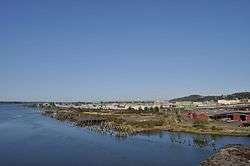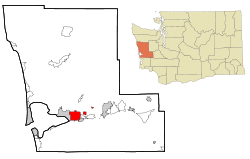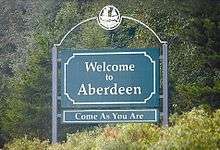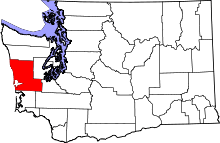Aberdeen, Washington
| Aberdeen, Washington | ||
|---|---|---|
| City | ||
| City of Aberdeen | ||
 | ||
| ||
| Nickname(s): Port of Missing Men | ||
| Motto(s): Come As You Are | ||
 Location within Grays Harbor County and Washington | ||
| Coordinates: 46°58′33″N 123°49′7″W / 46.97583°N 123.81861°WCoordinates: 46°58′33″N 123°49′7″W / 46.97583°N 123.81861°W | ||
| Country |
| |
| State |
| |
| County | Grays Harbor | |
| Incorporated | March 20, 1888 | |
| Government | ||
| • Type | Mayor–Council | |
| • Mayor | Erik Larson | |
| Area[1] | ||
| • City | 12.36 sq mi (32.01 km2) | |
| • Land | 10.65 sq mi (27.58 km2) | |
| • Water | 1.71 sq mi (4.43 km2) | |
| Elevation | 23 ft (7 m) | |
| Population (2010)[2] | ||
| • City | 16,896 | |
| • Estimate (2015)[3] | 16,276 | |
| • Density | 1,400/sq mi (530/km2) | |
| • Urban[4] | 29,856 | |
| • Metro[5] | 71,628 | |
| Demonym(s) | Aberdonian | |
| Time zone | UTC-8 (Pacific (PST)) | |
| • Summer (DST) | UTC-7 (PDT) | |
| ZIP code | 98520 | |
| Area code | 360 | |
| FIPS code | 53-00100 | |
| GNIS ID | 1511950 [6] | |
| Website | aberdeenwa.gov | |
Aberdeen /ˈæbərdiːn/ is a city in Grays Harbor County, Washington, United States. The population was 16,896 at the 2010 census. The city is the economic center of Grays Harbor County, bordering the cities of Hoquiam and Cosmopolis. Aberdeen is often referred to as the "Gateway to the Olympic Peninsula" and the "Home of Kurt Cobain".
History

Aberdeen was named after a local salmon cannery to reflect its Scottish fishing port namesake Aberdeen, and because it, too, is situated at the mouth of two rivers (Aberdeen, Scotland is bordered by the River Don to the north and the River Dee to the south).
Aberdeen was founded by Samuel Benn in 1884 and incorporated on May 12, 1890. Although it became the largest and best-known city in Grays Harbor, Aberdeen lagged behind nearby Hoquiam and Cosmopolis in its early years. When A.J. West built the town's first sawmill in 1894, the other two municipalities had been in business for several years. Aberdeen and its neighbors vied to be the terminus for Northern Pacific Railroad, but instead of ending at one of the established mill towns, the railroad skimmed through Cosmopolis and headed west for Ocosta. Hoquiam and Aberdeen citizens together built a spur; in 1895, the line connected Northern Pacific tracks to Aberdeen.
By 1900, Aberdeen had become home to many saloons, whorehouses, and gambling establishments. It was nicknamed "The Hellhole of the Pacific", as well as "The Port of Missing Men" due to its high murder rate. One notable resident was Billy Gohl, known locally as Billy "Ghoul",[7] who was rumored to have killed at least 140 men. Gohl was ultimately convicted of two murders.[8][9]
Aberdeen was hit hard during the Great Depression, which saw the number of major local sawmills reduce from 37 to 9. The timber industry continued to boom, but by the late 1970s most of this resource had been logged. Most of the mills had closed down by the 1970s and 1980s.
Aberdeen is also the home port of the tall ship Lady Washington, a reproduction of a smaller vessel used by the explorer Captain Robert Gray, featured in the Pirates of the Caribbean film The Curse of the Black Pearl.
Geography
Aberdeen is at the eastern end of Grays Harbor, near the mouth of the Chehalis River and southwest of the Olympic Mountains. Grays Harbor is notable as the northernmost ria on North America's Pacific Coast because it has remained free of glaciers throughout the Quaternary due to unfavorable topography and warm temperatures. It is thought that, during glacial periods of the Quaternary, the Chehalis River was a major refugium for aquatic species, as was the west coast from the Olympic Peninsula southward for plants that later formed the northern part of the Pacific temperate rainforest in formerly glaciated areas.
According to the United States Census Bureau, the city has a total area of 12.36 square miles (32.01 km2), of which 10.65 square miles (27.58 km2) is land and 1.71 square miles (4.43 km2) is water.[1]
Climate
Aberdeen experiences a climate on the boundary between Mediterranean (Köppen Csb) and oceanic (Köppen Cfb). Although the rainfall is extremely high between October and March, July and August still have a distinct excess of evaporation over rainfall. Temperatures are generally very mild due to the proximity of the warm Pacific Ocean and the Kuroshio Current: snow is extremely rare although during December 1964 22.3 inches (57 cm) fell. Occasionally, southeasterly winds can cause very high temperatures. For example, in August 1981, the temperature in Aberdeen reached 105 °F (40.6 °C).
| Climate data for Aberdeen | |||||||||||||
|---|---|---|---|---|---|---|---|---|---|---|---|---|---|
| Month | Jan | Feb | Mar | Apr | May | Jun | Jul | Aug | Sep | Oct | Nov | Dec | Year |
| Record high °F (°C) | 66 (19) |
73 (23) |
82 (28) |
88 (31) |
96 (36) |
101 (38) |
105 (41) |
105 (41) |
100 (38) |
86 (30) |
73 (23) |
63 (17) |
105 (41) |
| Average high °F (°C) | 45.8 (7.7) |
49.4 (9.7) |
52.9 (11.6) |
57.1 (13.9) |
61.8 (16.6) |
65.5 (18.6) |
69.1 (20.6) |
69.8 (21) |
68.5 (20.3) |
61.3 (16.3) |
52.0 (11.1) |
46.6 (8.1) |
58.3 (14.6) |
| Average low °F (°C) | 34.6 (1.4) |
35.3 (1.8) |
36.7 (2.6) |
39.4 (4.1) |
43.9 (6.6) |
48.5 (9.2) |
51.3 (10.7) |
51.9 (11.1) |
48.7 (9.3) |
43.7 (6.5) |
38.7 (3.7) |
35.7 (2.1) |
42.4 (5.8) |
| Record low °F (°C) | 6 (−14) |
8 (−13) |
18 (−8) |
13 (−11) |
22 (−6) |
32 (0) |
34 (1) |
36 (2) |
30 (−1) |
19 (−7) |
11 (−12) |
6 (−14) |
6 (−14) |
| Average precipitation inches (mm) | 12.78 (324.6) |
9.73 (247.1) |
8.85 (224.8) |
5.76 (146.3) |
3.68 (93.5) |
2.66 (67.6) |
1.20 (30.5) |
1.61 (40.9) |
3.50 (88.9) |
7.31 (185.7) |
12.54 (318.5) |
13.5 (343) |
83.2 (2,113) |
| Average snowfall inches (cm) | 4.4 (11.2) |
1.9 (4.8) |
0.7 (1.8) |
0.1 (0.3) |
0 (0) |
0 (0) |
0 (0) |
0 (0) |
0 (0) |
0 (0) |
0.4 (1) |
1.1 (2.8) |
8.6 (21.9) |
| Average precipitation days (≥ 0.01 inch) | 21 | 18 | 20 | 17 | 13 | 11 | 6 | 7 | 10 | 16 | 20 | 22 | 181 |
| Source: [10] | |||||||||||||
Demographics
| Historical population | |||
|---|---|---|---|
| Census | Pop. | %± | |
| 1890 | 1,638 | — | |
| 1900 | 3,747 | 128.8% | |
| 1910 | 13,660 | 264.6% | |
| 1920 | 15,337 | 12.3% | |
| 1930 | 21,723 | 41.6% | |
| 1940 | 18,846 | −13.2% | |
| 1950 | 19,653 | 4.3% | |
| 1960 | 18,741 | −4.6% | |
| 1970 | 18,489 | −1.3% | |
| 1980 | 18,739 | 1.4% | |
| 1990 | 16,565 | −11.6% | |
| 2000 | 16,461 | −0.6% | |
| 2010 | 16,896 | 2.6% | |
| Est. 2016 | 16,334 | [11] | −3.3% |
| U.S. Decennial Census[12] 2015 Estimate[3] | |||
2010 census
As of the census[2] of 2010, there were 16,896 people, 6,476 households, and 4,020 families residing in the city. The population density was 1,586.5 inhabitants per square mile (612.6/km2). There were 7,338 housing units at an average density of 689.0 per square mile (266.0/km2). The racial makeup of the city was 80.4% White, 0.8% African American, 3.7% Native American, 1.9% Asian, 0.3% Pacific Islander, 8.0% from other races, and 4.9% from two or more races. Hispanic or Latino of any race were 15.8% of the population.
There were 6,476 households of which 33.1% had children under the age of 18 living with them, 39.9% were married couples living together, 15.0% had a female householder with no husband present, 7.1% had a male householder with no wife present, and 37.9% were non-families. 29.2% of all households were made up of individuals and 10.8% had someone living alone who was 65 years of age or older. The average household size was 2.56 and the average family size was 3.10.
The median age in the city was 35.6 years. 24.9% of residents were under the age of 18; 10.5% were between the ages of 18 and 24; 25.8% were from 25 to 44; 26% were from 45 to 64; and 13% were 65 years of age or older. The gender makeup of the city was 49.8% male and 50.2% female.
2000 census
As of the census of 2000, there were 16,461 people, 6,517 households, and 4,112 families residing in the city. The population density was 1,548.8 people per square mile (597.9/km²). There were 7,536 housing units at an average density of 709.1 per square mile (273.7/km²). The racial makeup of the city was 84.87% White, 0.47% African American, 3.70% Native American, 2.10% Asian, 0.14% Pacific Islander, 5.15% from other races, and 3.57% from two or more races. Hispanic or Latino of any race were 9.22% of the population. 16.4% were of German, 9.3% English, 9.3% American, 8.7% Irish and 5.9% Norwegian ancestry according to Census 2000. 90.2% spoke only English, while 7.7% spoke Spanish at home.
There were 6,517 households out of which 31.8% had children under the age of 18 living with them, 43.9% were married couples living together, 13.7% had a female householder with no husband present, and 36.9% were non-families. 29.5% of all households were made up of individuals and 12.0% had someone living alone who was 65 years of age or older. The average household size was 2.49 and the average family size was 3.05.
In the city, the population was spread out with 26.8% under the age of 18, 10.3% from 18 to 24, 27.1% from 25 to 44, 21.9% from 45 to 64, and 14.0% who were 65 years of age or older. The median age was 35 years. For every 100 females, there were 98.0 males. For every 100 females age 18 and over, there were 96.0 males.
The median income for a household in the city was $30,683, and the median income for a family was $37,966. Males had a median income of $32,710 versus $20,446 for females. The per capita income for the city was $16,092. About 16.1% of families and 22.2% of the population were below the poverty line, including 29.7% of those under age 18 and 9.6% of those ages 65 or over.
Industry
Aberdeen and the rest of Grays Harbor remain dependent on the timber, fishing industries, tourism and as a regional service center for much of the Olympic Peninsula. Grays Harbor Community Hospital employees total more than 700. Historically the area is dependent on harvesting and exporting natural resources. The Port of Grays Harbor is the largest coastal shipping port north of California. It is still a center for the export of logs on the west coast of the U.S.and has become one of the largest centers for the shipment of autos and grains to China and Korea.
On December 19, 2005, Weyerhaeuser closed the Aberdeen large-log sawmill and the Cosmopolis pulp mill in early 2006. This resulted in the loss of at least 342 jobs. In January 2009, Weyerhaeuser closed two additional plants in Aberdeen, resulting in another 221 lost jobs. In both cases many employees were not told by Weyerhaeuser management, but learned about the closures from local radio stations who received a press release prior to a scheduled press conference.[13]
Major employers in Grays Harbor include Westport Shipyard, Sierra Pacific Industries, The Simpson Door Company, Hoquiam Plywood, Pasha Automotive, Willis Enterprises, Ocean Gold Companies, Vaughn Company, and the Stafford Creek Corrections Center, a state prison which opened in 2000.[14]
Other significant employers include the cranberry-growing cooperative Ocean Spray, worldwide retailer Wal-Mart, Sidhu & Sons Nursery USA, Inc. (AKA Briggs Nursery), Overstock.com, and Washington Crab Producers.
In 2007, Imperium Renewables of Seattle invested $40 million in the construction of the biodiesel plant at the Port of Grays Harbor. It is estimated the plant will produce as much as 100 million US gallons (380,000 m3) of biodiesel fuel made from plants and vegetable material annually.[15]
In September 2010, the Weyerhaeuser Cosmopolis Pulp Mill was purchased by the Beverly Hills-based Gores Group and restarted as Cosmo Specialty Fibers, Inc. They started production of pulp on May 1, 2011.
Education
The city's school district has two high schools: J. M. Weatherwax High School, or Aberdeen High School as it is now called; and Harbor High School, an alternative high school with an enrollment exceeding 200 students. Aberdeen High has a long-time school sports rivalry with nearby Hoquiam High School.
In 2002, the Weatherwax building of Aberdeen High School, built in 1909, burned to the ground. The new building was completed in 2007 and held its grand opening on August 25, 2007.
Aberdeen School District also consists of one junior high: Miller Junior High; five elementary schools: Central Park Elementary, McDermoth Elementary, Stevens Elementary, AJ West Elementary and Robert Gray Elementary; and one Roman Catholic parochial school: St. Mary's Catholic School.
Aberdeen is home to Grays Harbor College, located in south Aberdeen, and is represented by the Charlie Choker mascot. The college emphasizes student opportunities and has resources to help students transfer to a four-year college to complete a degree.
Aberdeen Timberland Library is the largest public library in Grays Harbor County, and is part of Timberland Regional Library.
Crime
| Aberdeen | |
|---|---|
| Crime rates* (2012) | |
| Violent crimes | |
| Homicide | 1 |
| Robbery | 18 |
| Aggravated assault | 27 |
| Total violent crime | 59 |
| Property crimes | |
| Burglary | 221 |
| Larceny-theft | 605 |
| Motor vehicle theft | 81 |
| Arson | 2 |
| Total property crime | 907 |
|
Notes *Number of reported crimes per 100,000 population. 2012 population: 17,000 Source: 2012 FBI UCR Data | |
According to Uniform Crime Report statistics compiled by the Federal Bureau of Investigation (FBI) in 2012, there were 59 violent crimes and 907 property crimes per 100,000 residents. Of these, the violent crimes consisted of 13 forcible rapes, 18 robberies and 27 aggravated assaults, while 221 burglaries, 605 larceny-thefts, 81 motor vehicle thefts and 2 instances of arson defined the property offenses.[16]
Notable people
- Robert Arthur, actor and gay rights activist
- Elton Bennett, artist
- Mark Bruener, professional football player [17]
- Trisha Brown, choreographer
- Daniel Bryan, professional wrestler
- Jeff Burlingame, author
- Hank Woon, author, game designer, screenwriter
- Robert Cantwell, novelist
- Calvin Fixx, writer
- Lee Friedlander, artist and photographer
- Billy Gohl, serial killer
- Victor Grinich, pioneer of Silicon Valley
- Walt Morey, writer and creator of Gentle Ben
- Robert Motherwell, painter of New York School
- Ed Murray, Democratic politician and Mayor of Seattle 2014-17
- Peter Norton, computer programmer
- Douglas Osheroff, winner of Nobel Prize in Physics
- Craig Raymond, basketball player, 12th pick of 1967 NBA draft
- Wesley Carl Uhlman, politician
- John Workman, writer, artist
- Yukon Eric, professional wrestler
- Colin Cowherd, sports media personality
Musicians
- The Doobie Brothers' Patrick Simmons
- The Melvins, specifically Dale Crover and Matt Lukin
- Nirvana, specifically Kurt Cobain and Krist Novoselic
- Kurdt Vanderhoof of Metal Church, the Lewd and Presto Ballet
- Chris Freeman
- For The Likes Of You, a Metalcore band formed in 2011.
Sister cities
References
- 1 2 "US Gazetteer files 2010". United States Census Bureau. Archived from the original on July 14, 2012. Retrieved December 19, 2012.
- 1 2 "American FactFinder". United States Census Bureau. Archived from the original on February 17, 2012. Retrieved December 19, 2012.
- 1 2 "Population Estimates". United States Census Bureau. Archived from the original on October 19, 2016. Retrieved June 18, 2016.
- ↑ "Aberdeen, WA Urban Cluster Summary" (PDF). (Washington State) Office of Financial Management. Retrieved June 10, 2018.
- ↑ "Aberdeen, WA Micro Area". Census Reporter. Retrieved June 10, 2018.
- ↑ "Aberdeen". Geographic Names Information System. United States Geological Survey.
- ↑ "Billy Gohl". Serial Killer Central. Archived from the original on 2010-01-05.
- ↑ "Billy Gohl of Grays Harbor". Tacoma Public Library. Archived from the original on October 24, 2008. Retrieved September 6, 2007.
- ↑ "Billy Gohl". Crime Life. com. Archived from the original on February 6, 2013. Retrieved September 6, 2007.
- ↑ "ABERDEEN, WASHINGTON (450008)". Western Regional Climate Centre. Retrieved October 31, 2008.
- ↑ "Population and Housing Unit Estimates". Retrieved June 9, 2017.
- ↑ "U.S. Decennial Census". Census.gov. Archived from the original on May 12, 2015. Retrieved May 28, 2014.
- ↑ White, Callie (January 26, 2009). "Weyerhaeuser closes Aberdeen sawmill, Pacific Veneer". The Daily World.
- ↑ "Grays Harbor Workforce". Greater Grays Harbor Inc. 2015. Retrieved June 13, 2015.
- ↑ "Imperium Renewables Celebrates Opening of Nation's Largest Biodiesel Production Facility" (PDF). Imperium Renewables Inc. August 15, 2007. Archived from the original (PDF) on March 6, 2015. Retrieved June 13, 2015.
- ↑ "Washington - Offenses Known to Law Enforcement by City, 2012". Federal Bureau of Investigation. 2012. Retrieved May 28, 2014.
- ↑ "Aberdeen Bobcat Hall of Fame". Aberdeen High School. Retrieved October 5, 2017.
- 1 2 "Sister City Relationships: Annex A: Sister Relations in Washington State (USA)". Australia-China Chamber of Commerce and Industry of New South Wales. 2001. Retrieved June 13, 2015.
Further reading
- Jeff Burlingame, "Kurt Cobain: 'Oh Well, Whatever, Nevermind'" Enslow Publishers, 2006.
- Jeff Burlingame, "Moon Olympic Peninsula" Avalon Travel, 2012.
- Anne Cotton, "The History of Aberdeen," Grays Harbor Regional Planning Commission, 1982.
- John C. Hughes & Ryan Teague Beckwith, "On the Harbor: From Black Friday to Nirvana," Stephens Press, LLC. 2005.
- Murray Morgan, "The Last Wilderness," Viking Press, 1955.
- Ed Van Syckle, "The River Pioneers," Pacific Search Press, 1982.
- Ed Van Syckle, "They Tried to Cut It All," Pacific Search Press, 1980.
- Robert A. Weinstein, "Grays Harbor, 1885-1913", Viking Press, 1978
- John Workman, "The Third Man" chapter in "Against the Grain: Mad Artist Wallace Wood" compiled by Bhob Stewart, TwoMorrows Publishing, 2003.
- John Workman, "Betty Being Bad" Fantagraphics Books, 1990.
External links
| Wikivoyage has a travel guide for Aberdeen (Washington). |
| Wikimedia Commons has media related to Aberdeen, Washington. |
| Wikisource has the text of a 1921 Collier's Encyclopedia article about Aberdeen. |
- Official city website
- Aberdeen, Washington at Curlie (based on DMOZ)


